Garden Furniture
Custom modules and extensions
Attention Some modules may not be included into your template package. This section describes configuration of all modules that are used in our templates. Each template pack is provided with a set of modules which is included into the design of this specific template.
TM Collections
TM Collections module is created to give the ability to the visitors of online store to add products to collections and share these collections on Facebook.
Module Installation
То install the module navigate to Admin panel -> Modules -> Modules and Services, find the TM Collections module and press 'Install' button (1).

Module Configuration
After the module has been installed, the 'Settings' page will appear.
Add the Facebook App Id to the required field (1) and press 'Save' button (2).
The instruction how to get the Facebook App Id can be found here: Creating an App ID.

Using TM Collections Module
Adding product to collection
Shop visitors should be logged in to be able to add the items to collections.
-
After the module is installed, the button 'Add to collection' appears on each product page. It should look like on the screenshot below (1).
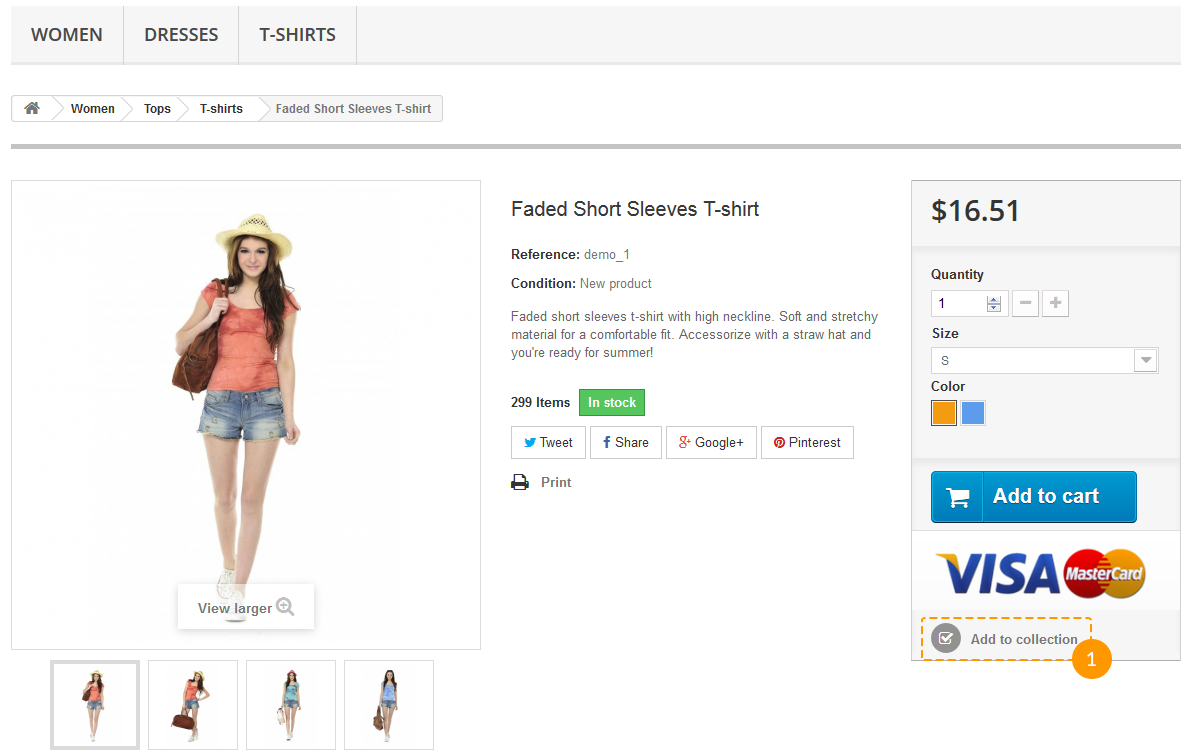
-
After clicking this button a shop visitor will see a notification: 'The product was successfully added to your collection.' It can be closed or skipped to collections view by clicking 'My collections' button (2).

Browsing Collections
-
On 'My Collections' page a client can add the new collection (1) or view the list of created ones (2).

-
Clicking 'View collection' button (1) will open the collection page, the 'View products' button (2) gives the ability to see the products list of this collection on current page.
The title of collection can de edited (3) or deleted (4).
To share the collection the visitor should press the 'Share' button (5).
-
While looking through the items in collection after clicking 'View products' button, each item can be removed from the list (1).
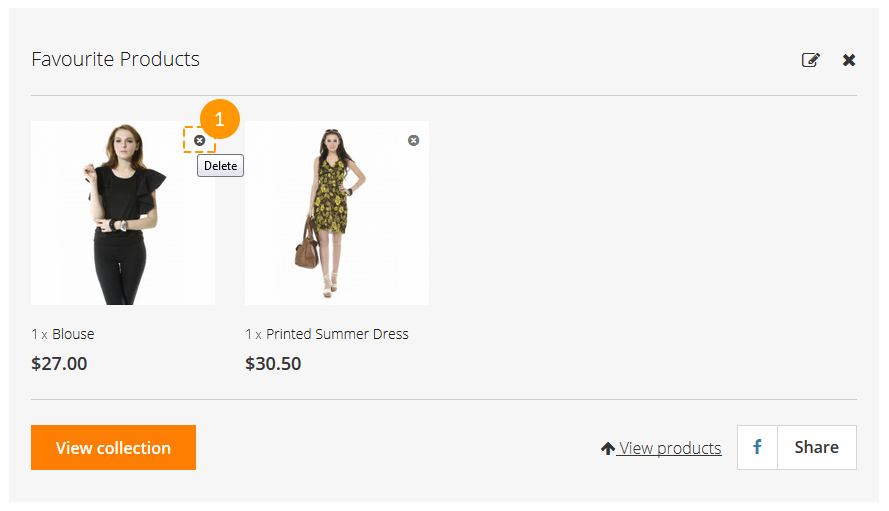
Sharing Collections
To share the collection the visitor should press the 'Share' button. There will be a few easy steps to follow before posting the collection. During each step there's an ability to go back and change the sharing options.
-
First step is to choose the layout for collection that will be posted.

-
Then the products should be added. Each cell with a '+' is a button to add the product image.
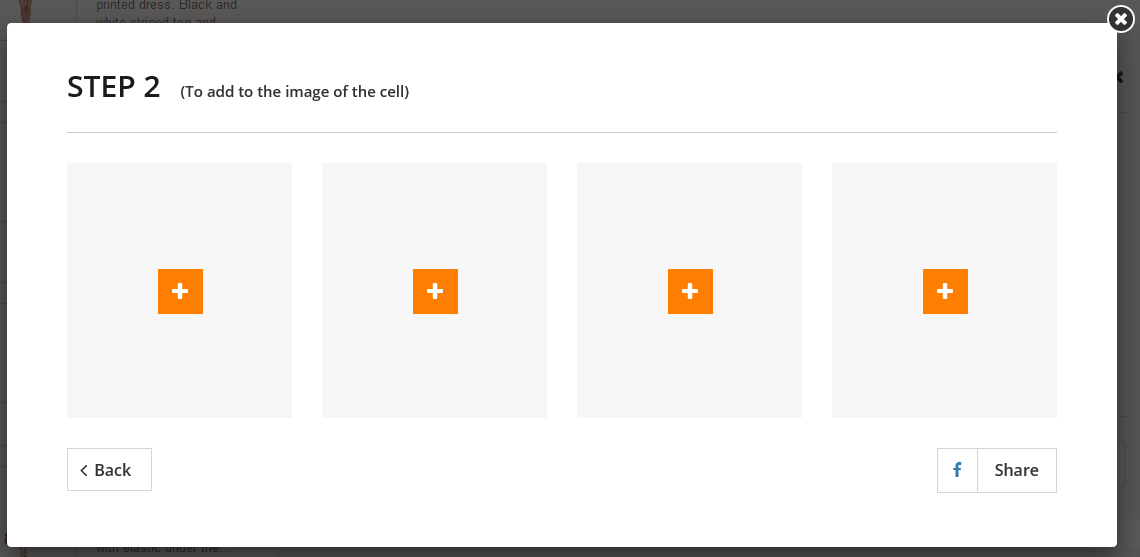
Choosing the images of each product:
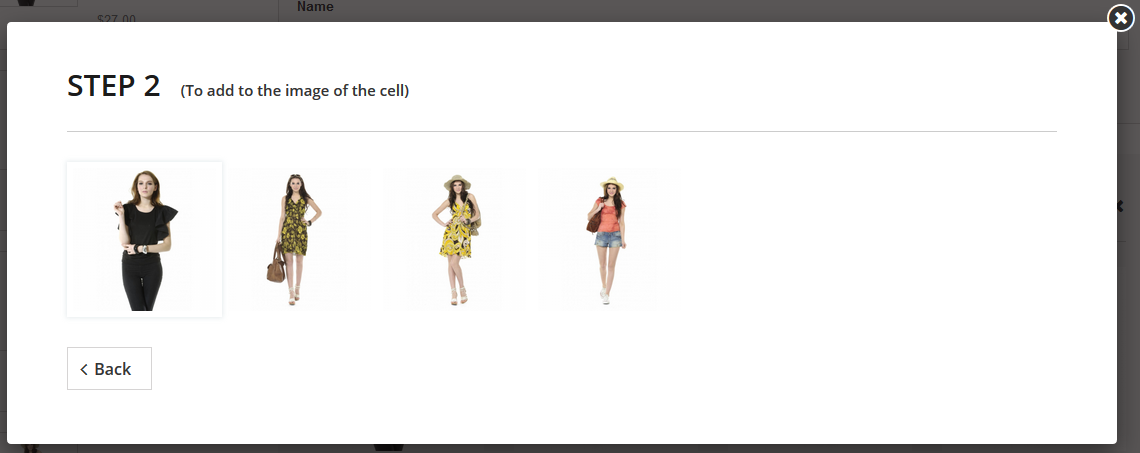
-
When all images are added, the visitor should press the 'Share' button (1).

-
In a small window which is then appeared, there will be some standard posting options to choose and the ability to add some text to the post (1). After clicking 'Post to Facebook' button (2), the post will be published.
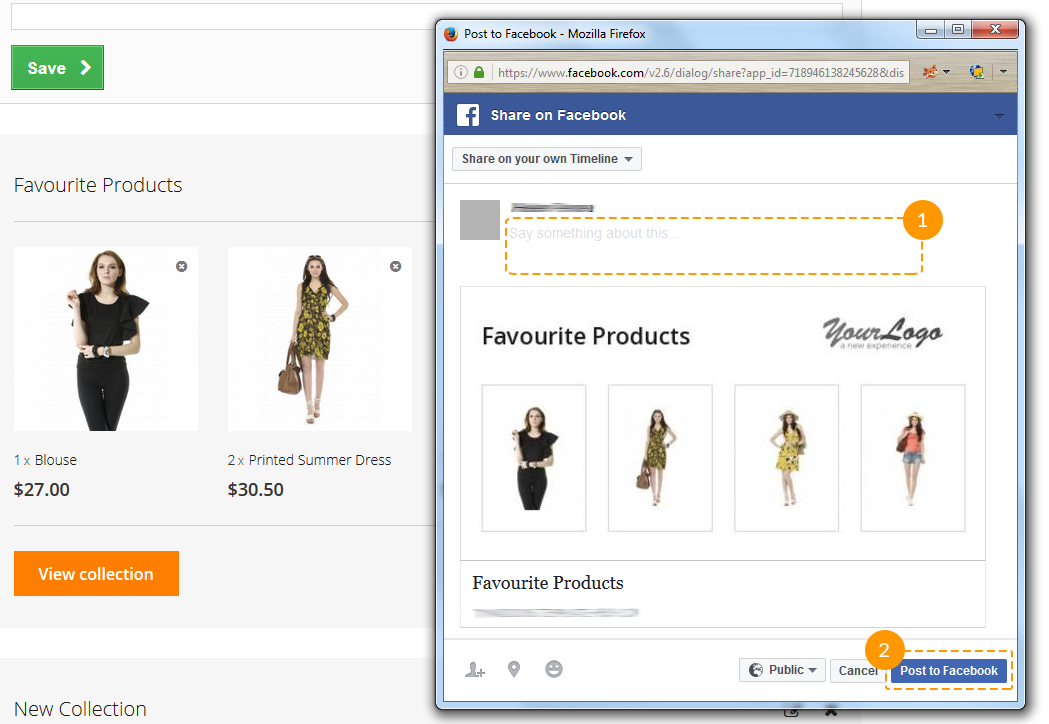
Statistics
Using this module you can also get the statistics collected while the products are added to collections. Thus you
will know which products are currently popular. This information can be very useful for suggesting a discount, for
example.
You can view the statistics navigating to Admin panel -> Stats -> Stats -> TM Collections.
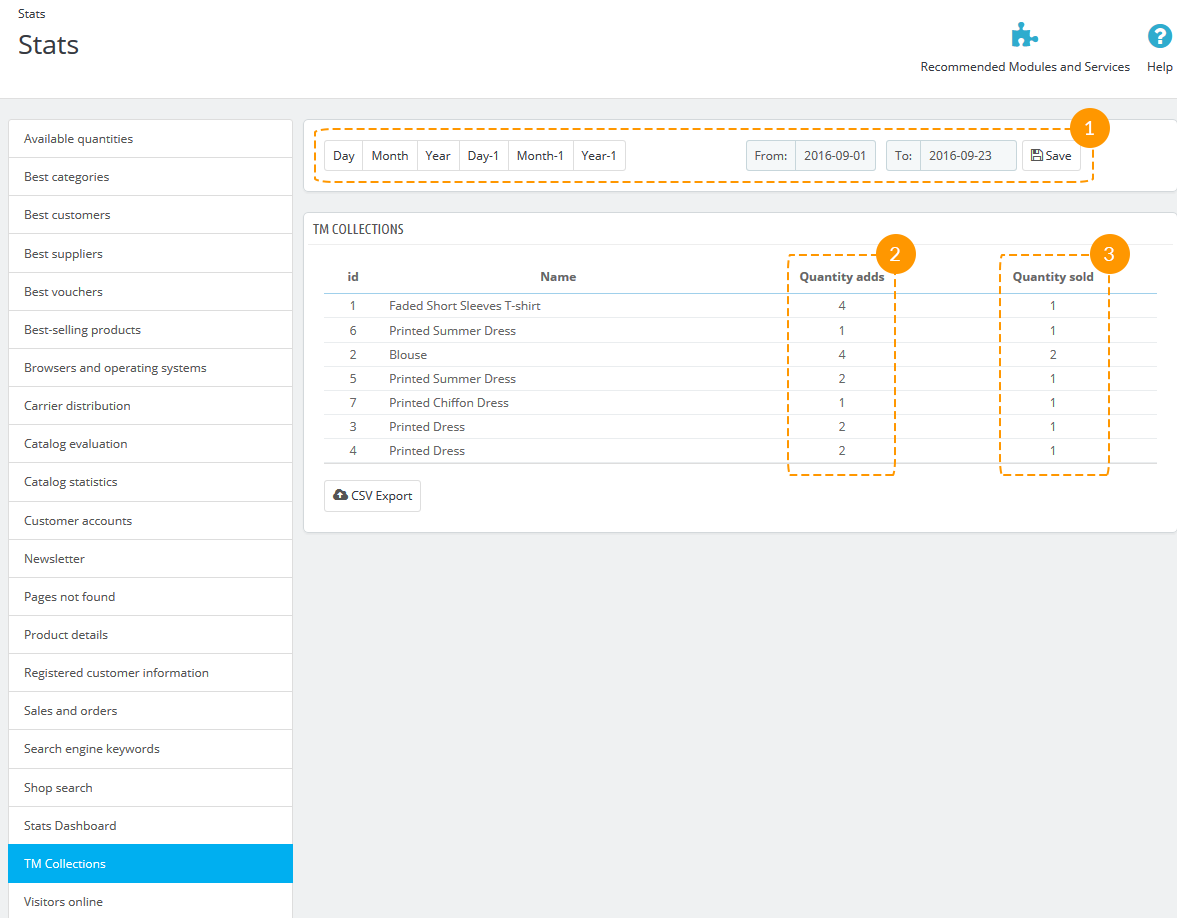
- You can select the period for viewing the statistics from the specified time (1).
- In the first column there's a number of product addings (2).
- The second column is created for your convenience. You can use it to see how many of added products were sold (3).
TM Header Account 2.0.0
This module displays login and registration forms on the website. It can take the following positions: website header, left and right column. The module allows to log in and register using such social networks as Facebook, Google+ and VK, which is convenient for website users. Registration or logging in proceeds without reloading the page.
TM Header Account Main Panel
The main panel. Here you can set up the module.
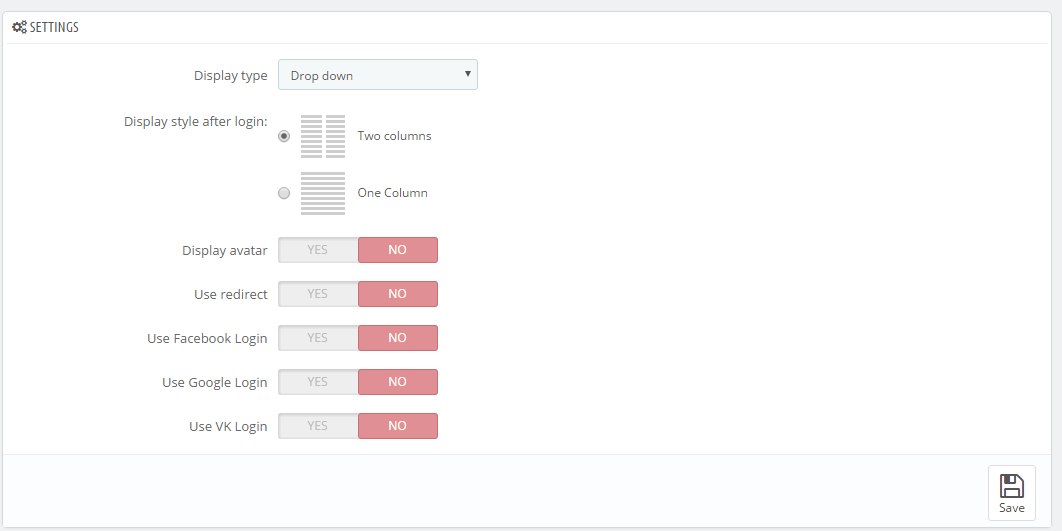
Settings
There are the following settings in the module:
Display type - this setting allows to select the way to display the registration form. It can take the following values:
- Drop down - the form will display as a drop-down below the button opening it.

- Popup - the form will appear in a pop-up.
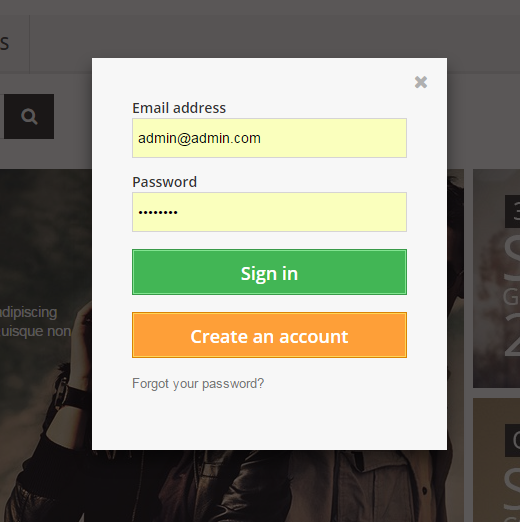
- Left side - the form will appear from the left as a sidebar.

- Right side - the form will appear from the right as a sidebar.
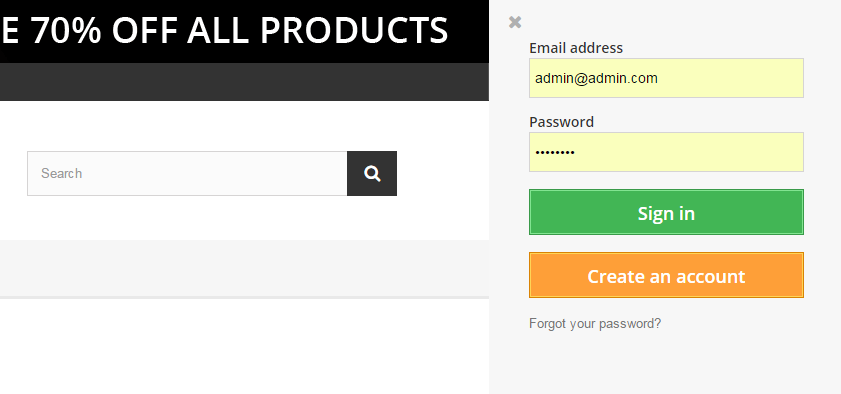
- Drop down - the form will display as a drop-down below the button opening it.
Display style after login - this setting allows to change the form view after login/registration. You can use the following values:
- Two columns - the list is divided into two columns.

- One Column - the list of links is displayed as one column.

- Two columns - the list is divided into two columns.
- Default avatar - this field appears only if the 'Display avatar' option is enabled. Here you can select the default user avatar.
- Display avatar - this setting allows to enable or disable user avatar. If the user logs in to the account on the website with the help of one of the social networks, the avatar will be taken from the account in this social network, otherwise, the avatar, loaded by the website admin, will be displayed.
- Use redirect - if this setting is enabled, user registration and password recovery will take place on the default PrestaShop registration/password recovery page.
Use Facebook Login - this setting allows to enable user registration and login with the help of Facebook social network. When you enable this option, you will see the following settings:
- App ID - your account App ID from the Facebook developer account.
- App Secret - your app secret from the Facebook developer account.
Use Google Login - this setting allows to enable user login and registration with the help of Google+ social network. If you enable this option, you will see the following settings:
- App ID - your App id from the Google developer account.
- App Secret - your App secret from the Google developer account.
- Redirect URIs - your online-store url + index.php?fc=module&module=tmheaderaccount&controller=googlelogin
Use VK Login - this setting allows to enable user registration and login with the help of VK social network. If you enable this option, you will see the following settings:
- App ID - your App id from your VK developer account.
- App Secret - App secret from your VK developer account.
- Redirect URIs - your online-store url + index.php?fc=module&module=tmheaderaccount&controller=vk
Registering apps in social networks:
- Facebook - to get App ID and App Secret, register your app at https://developers.facebook.com/apps.
- Google+ - to get App ID and App Secret, register your app at https://developers.google.com/accounts/docs/OAuth2/.
- VK - to get App ID and App Secret register your app at https://vk.com/dev.
TM HTML Content
This module allows to display any content (image, HTML, links, etc.) in the following positions: displayNav, home, top, topColumn, left and right (displayLeftColumn/displayRightColumn), footer. It is used to expand design opportunities and add advertisement/information blocks to your store. It is a multilanguage module and can also work in the multistore website.
Installation and Deleting
The module can be installed and deleted like any other PrestaShop module.
Module configuration
After the module has been successfully installed, open the configuration page.
To add the content, you should follow the steps below:
- Click 'Add new' button.
- The list of available languages. You can view the available elements for all languages by switching the language tabs.
- The list of elements added for specific position and language.
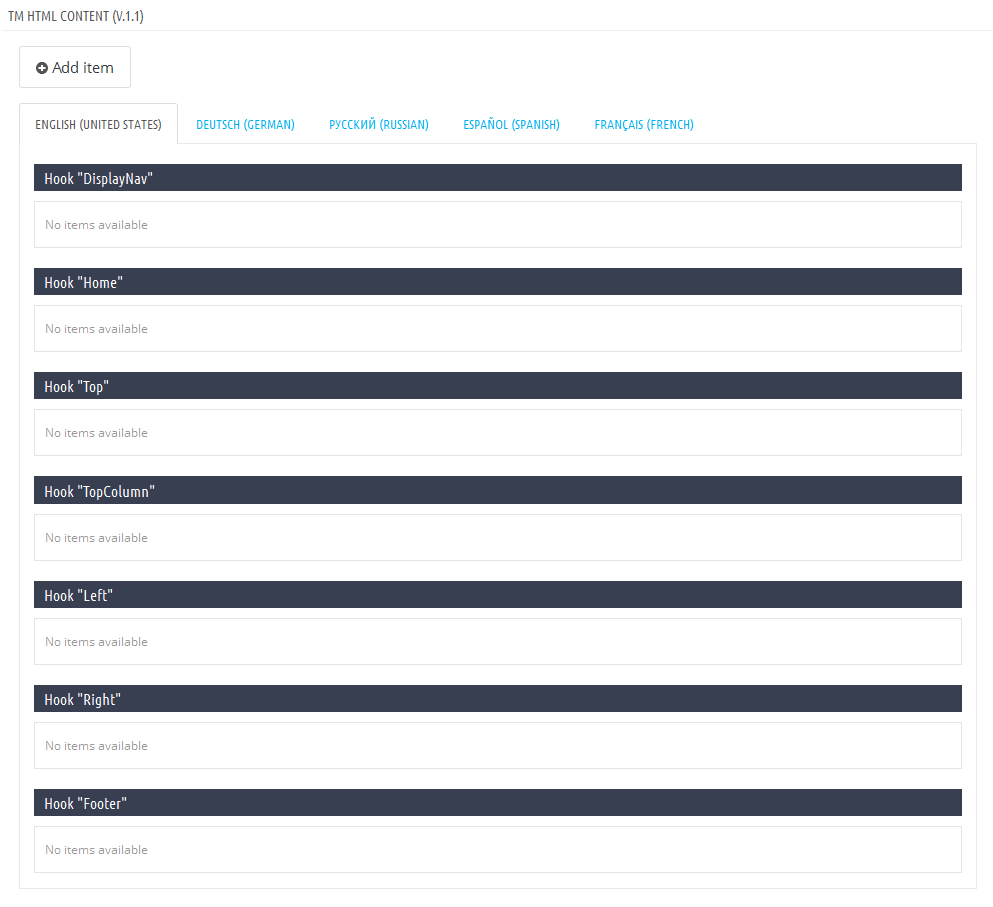
Adding the element. Click Add item button and fill in the required settings (none of the fields are mandatory).
All elements of one language added to the same position will be displayed as a list at the backend and frontend.
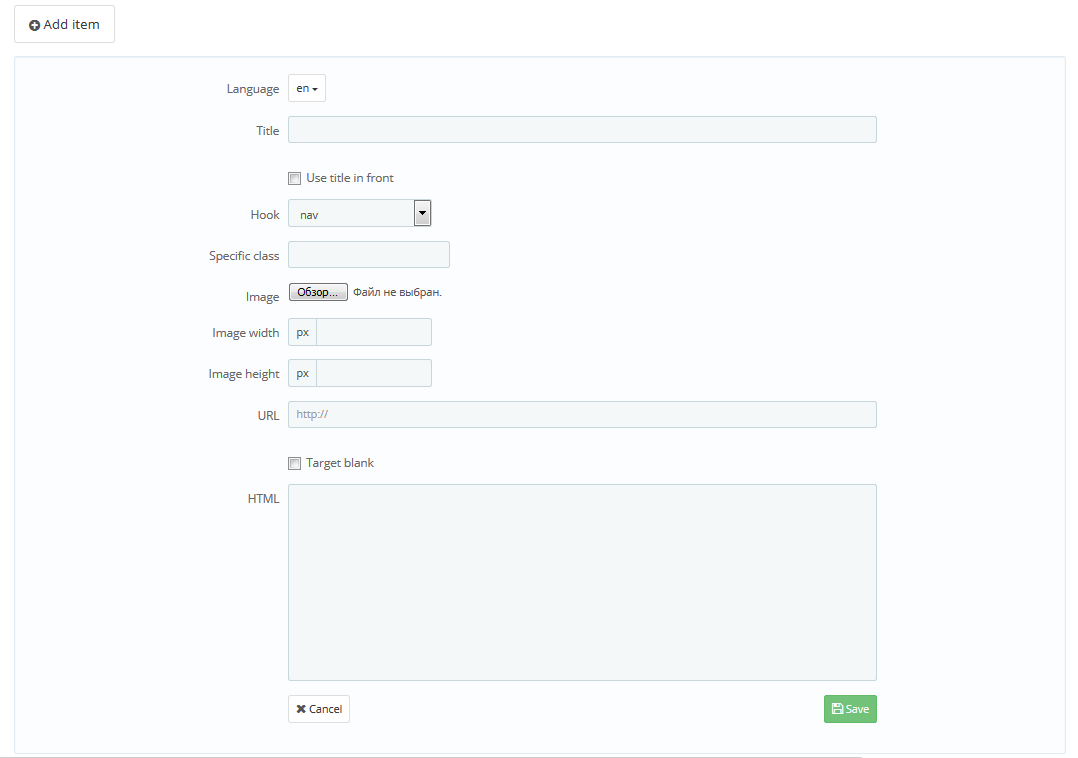
-
- Language
- select the required language from the drop-down list.
-
- Title
- title of the element.
-
- Use title in front
- display the title of the element at the frontend (the title will show up in front of the element).
-
- Hook
- position where the element is added.
-
- Specific class
- custom class, defines item styling (CSS class).
-
- Image
- upload the image from your computer.
-
- Image width
- image width shown at the frontend.
-
- Image height
- image height shown at the frontend.
-
- URL
- add the link (the whole block will be wrapped in the link).
-
- Target blank
- open link in new tab.
-
- HTML
- HTML code (except the link if you have added it in the URL field) or text.
-
- Save
- click to save the element.
Editing and removing the element
When you add the element, it shows up in the corresponding list.
- The language where the elements were added.
- Position where the elements were added.
- Edit button with the drop-down list.
- Delete button.

Editing
Click Edit button to modify the element.
In the appeared screen change all the required fields.
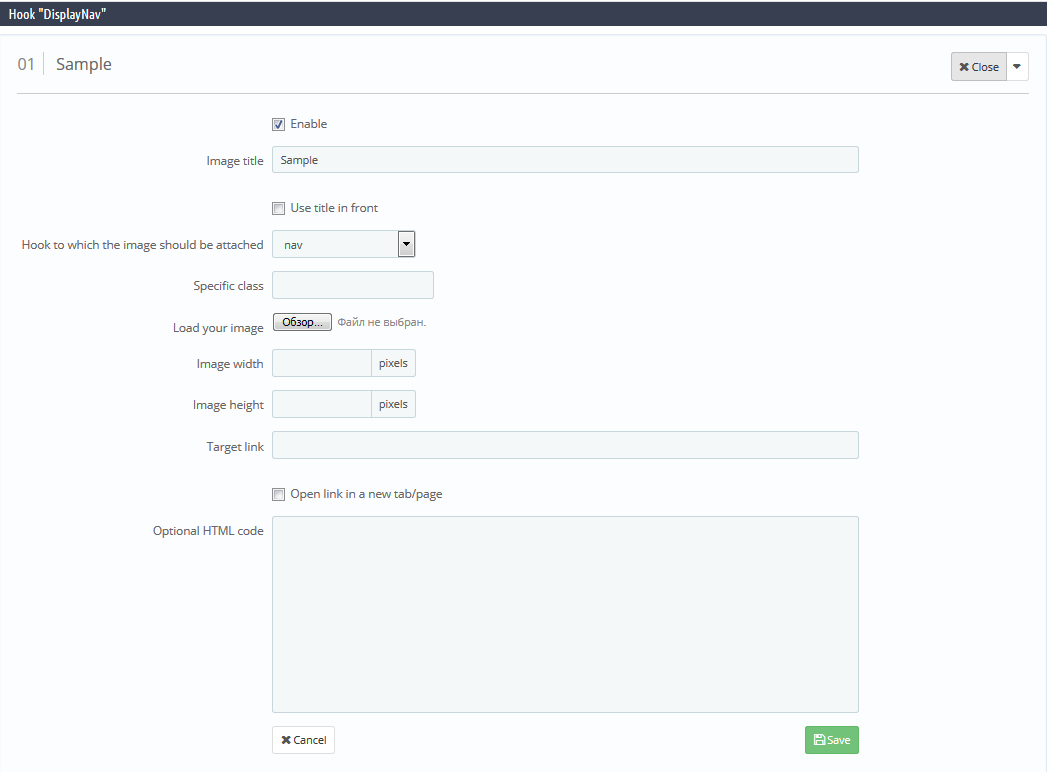
-
- Enable
- display the element at the frontend.
-
- Image title
- title of the element.
-
- Use title in front
- show up title at the frontend.
-
- Hook to which the image should be attached
- position of the element.
-
- Specific class
- custom CSS class.
-
- Load your image
- image of the element.
-
- Image width
- image width at the frontend.
-
- Image height
- image height at the frontend.
-
- Target link
- assign link to the element.
-
- Open link in a new tab/page
- Open link in new tab.
-
- Optional HTML code
- edit HTML code.
-
- Save
- save changes.
Changing order of elements in the list

To change the order of elements, you should just drag the element to the position you need.


TM Media Parallax 2.0.0
This module is designed to let you add parallax effect to the DOM items of the page. It allows you to create multi-layered parallax. It also provides a possibility to add a custom background video (you can upload it from your computer to server) or add a YouTube video.
TM Media Parallax Main Panel
Main module panel that allows you to add, edit or remove parallax items.

Creating a new parallax item
In order to create a new parallax item, press 'plus' (1) icon, in the top right corner of the main panel.

Then you will see the following form.
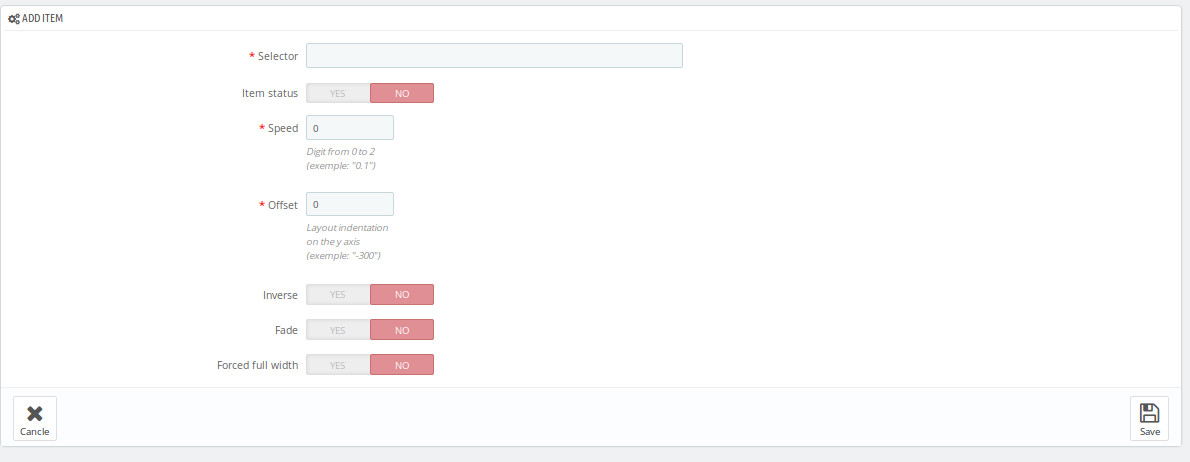
Form options for adding parallax items
- Selector - CSS selector of the item with parallax effect applied. For example, '#header .nav'
- Item status - item status (parallax will not be displayed if it's disabled)
- Speed - digit value from 0 to 2, which defines main parallax block speed
- Offset - main layer indent on the Y axis
- Inverse - parallax direction
- Fade - this option allows to configure main block fade-out on page scroll
- Forced full width - forced full width of the parallax block
Press 'Save' after filling in all the required fields.
Parallax layers list
In order to see the list of parallax layers, you should press 'View' (1) near the main parallax item.

Then you'll see a table, in which the layers are displayed after they are added.

Adding new layer
In order to create a new parallax layer, press 'plus' (1) icon in the top right corner of the layers panel.

Then you will see the following form.
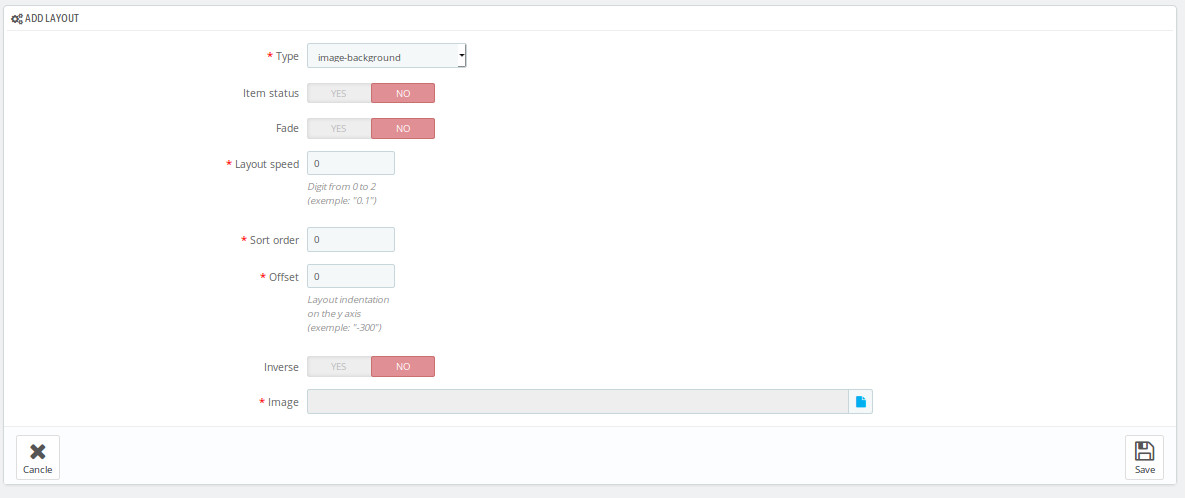
Press 'Save' after filling in all the required fields.
Parallax layers types and their fields
Image-background - image used as a parallax background
- Item status - item status (parallax will not be displayed if it's disabled)
- Layout speed - digit value from 0 to 2, which defines main parallax block speed
- Offset - main layer indent on the Y axis
- Inverse - parallax direction
- Fade - this option allows to configure main block fade-out on page scroll
- Image - link to an image, to which parallax effect will be applied
- Sort order - layout position, relative to the rest of items
Video-background - video used as a parallax background
- Item status - item status (parallax will not be displayed if it's disabled)
- Layout speed - digit value from 0 to 2, which defines main parallax block speed
- Offset - main layer indent on the Y axis
- Inverse - parallax direction
- Fade - this option allows to configure main block fade-out on page scroll
- Image - link to an additional image
- Video parallax mp4 - video in mp4 format
- Video parallax webm - video in webm format
- Sort order - layout position, relative to the rest of items
Text - text layer which position can be defined with CSS
- Item status - item status (parallax will not be displayed if it's disabled)
- Layout speed - digit value from 0 to 2, which defines main parallax block speed
- Offset - main layer indent on the Y axis
- Inverse - parallax direction
- Fade - this option allows to configure main block fade-out on page scroll
- Content - layer content
- Specific class - custom CSS class for this layer
- Sort order - layout position, relative to the rest of items
Youtube-background - YouTube video used as a parallax background
- Item status - item status (parallax will not be displayed if it's disabled)
- Layout speed - digit value from 0 to 2, which defines main parallax block speed
- Offset - main layer indent on the Y axis
- Inverse - parallax direction
- Fade - this option allows to configure main block fade-out on page scroll
- Video id - YouTube video ID
- Sort order - layout position, relative to the rest of items
Image - image layer which position can be defined with CSS
- Item status - item status (parallax will not be displayed if it's disabled)
- Layout speed - digit value from 0 to 2, which defines main parallax block speed
- Offset - main layer indent on the Y axis
- Inverse - parallax direction
- Fade - this option allows to configure main block fade-out on page scroll
- Image - link to an image, to which parallax effect will be applied
- Specific class - custom CSS class for this layer
- Sort order - layout position, relative to the rest of items
Uploading video and images to server
In order to upload video or an image to server via File Manager, first you need to press 'file' (1) icon next to the needed field.

In the following window, in the 'actions' line, choose 'upload' (2).
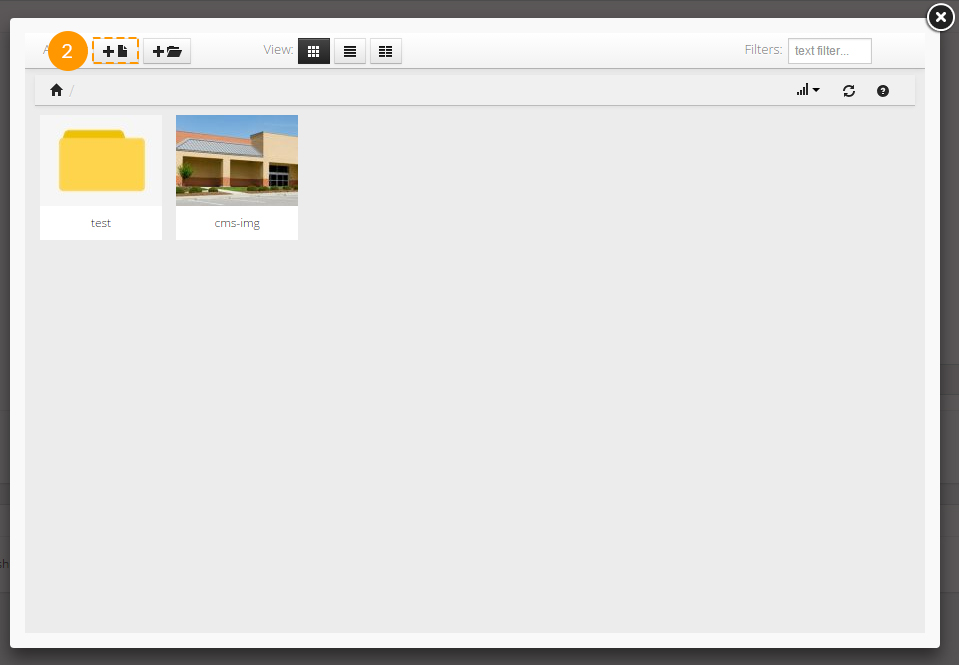
Then you'll see one more pop-up window, to upload image or video file here.
Warnings and recommendations
- Mobile devices (smartphones, tablets) have parallax effect disabled by default, the uppermost block image layer is used as a background instead
- Forced full width of the parallax block affects page loading speed more critically than a regular fullwidth block loading
- The smaller the size of the uploaded video, the better.
TM Mega Layout 1.1.0
This module is designed to allow creating custom layouts (presets) for hooks and displaying them at site instead of the default positions. This module advantage is allowing you to create different hook markups and modify them up to your needs.
Functional characteristics and features of the module
-
Requirements:
PrestaShop 1.6+
PHP 5.4+
-
Features:
Module includes 5 hooks: 'Header', 'Top Column', 'Home', 'Footer' and 'Product Footer'.
In case module is not present in the hook, it can't be added to the preset.
Module can be displayed in the preset only once, the same as in a hook.
Module position in 'Modules and Services -> Positions' section does not affect the preset.
The module does not allow you to configure different modules. You cannot set different modules configuration for various presets.
Module provides you with an option for changing module position and setting up the grid for 3 hooks: displayTopColumn, displayHome, displayFooter. Changing the modules position in 'Modules and Services -> Positions' section will not affect the modules position in the preset. In case the module was not added to the hook, it can't be added to the preset either.
Hooks
The module has 5 hooks available by default:
- 'Header' is a hook that combines 2 standard hooks: displayNav and displayTop. This hook corresponds to the website header.
- 'Top Column' corresponds to the original displayTopColumn hook. This hook comes right after the Header hook.
- 'Home' corresponds to the original displayHome hook. This hook is present only on the main page.
- 'Footer' corresponds to the original displayFooter hook.
- 'Product Footer' corresponds to the original displayFooterProduct hook, which is displayed in product page footer.
TM Mega Layout Main Panel
Main Layouts
The main TM Mega Layout module configuration panel that allows you to add a preset to the required hook and configure the preset.

Adding the preset
-
Press '+ Add Preset' (1) in the needed tab.

-
Next, fill in the 'Enter layout name' field in the popup typing the new preset (2) title there and press 'Save' (3).
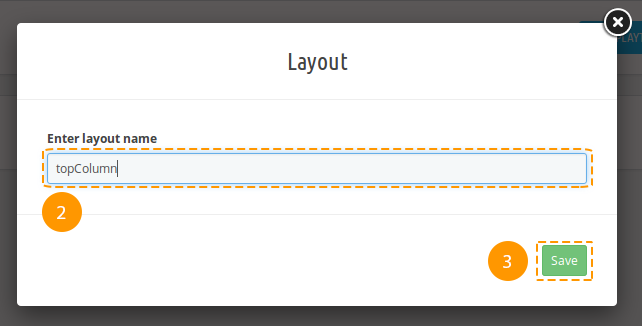
-
Preset was successfully created, it's listed among the available presets (4) now. Newly created preset is selected for editing (5).

Preset activation
-
First of all, select the needed preset from the list (1).

-
Press the 'Use as default' (2) switcher.

-
The preset was activated. If you need to display this preset only on some pages, open the dropdown (3) and select the pages you need. To apply changes, click outside the list area. A preset that is displayed on all pages will be marked with a filled star in the presets list, and the one that is displayed only on some pages will be marked with a partially filled star.

Removing the preset
There is no option to restore the preset after removing.
-
In order to remove the preset, choose the required preset among the list (1).

-
Next, press a cart (2) near the preset title.

-
Preset was successfully removed.
Renaming the preset
-
In order to rename the preset, choose the required preset among the list (1).

-
Next, press a pencil icon (2) next to the preset title.

-
Specify the new preset title (3) in a popup and press 'Rename layout' (4).
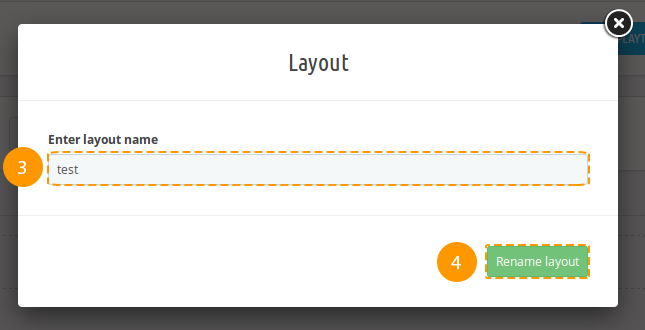
-
Preset was successfully renamed.
Wrapper
Wrapper has no class by default, it's not a mandatory item.
Adding the wrapper
-
In order to create a wrapper, press '+ Add wrapper' (1).

-
Wrapper was added (2).

Adding the custom CSS class to the wrapper
Adding the custom class will let you create a specific styling for your wrapper by using CSS rules.
-
In order to add wrapper class, press the button (1).

-
You'll see a pop-up window, fill in the 'Enter wrapper classes' (2) field there and press a 'Confirm' (3) button.
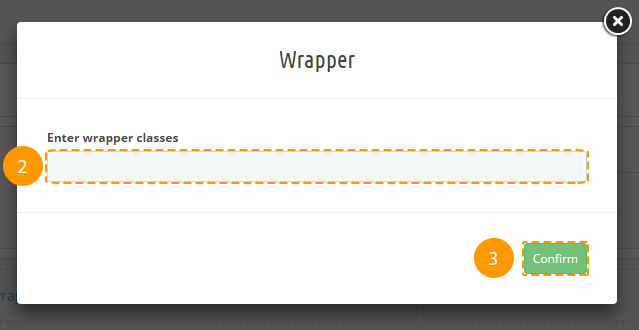
-
Custom class was added successfully.
Deleting the wrapper
Deleting the preset item will also cause all of its child items and their styles removing.
-
In order to remove the wrapper, press the cart button (1).

-
Wrapper was removed successfully.
Styling the wrapper
-
In order to add custom styles to the wrapper, press the 'pencil' (1) icon in the wrapper block.

-
In the following pop-up window fill in all the needed fields (you may refer to the documentation 'Styling' section), and press 'Save' (2) button.
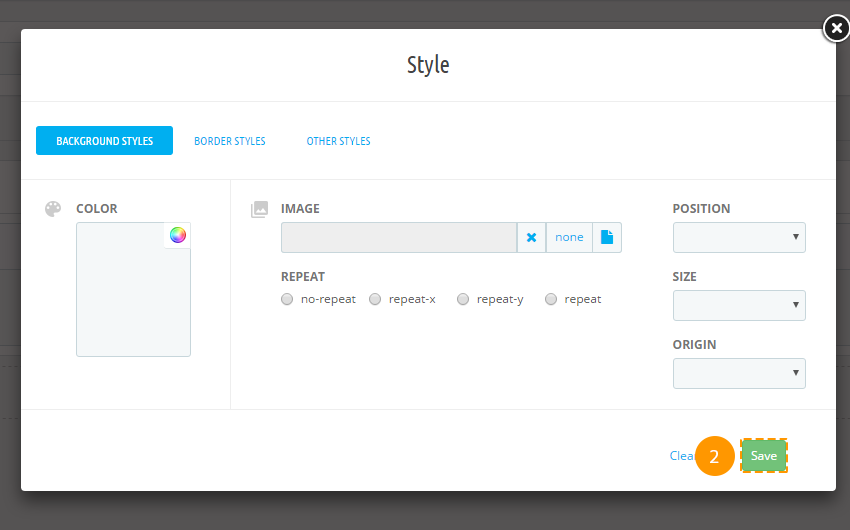
-
If all of the fields are filled in correctly, styles will be saved.
Row
Row item from the Bootstrap grid. It's a required item.
Adding the row
-
In order to insert a new row, press '+ Add row' (1) into the wrapper block, or '+ Add row' (2) in the main preset block, or '+ Add row' (3) in the column dropdown list.

-
The row was added successfully.
Adding custom CSS class to the row
Custom class adding allows you to create custom row styling using CSS rules.
-
In order to add the class to the row, you should press the 'ellipsis' button (1).

-
Choose the 'Edit row' (2) in a dropdown list.

-
Fill in the 'Enter row classes' (3) field in the pop-up window and press 'Confirm' (4) button.
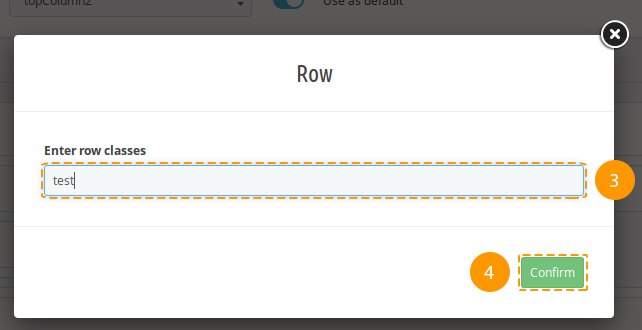
-
Custom class was added successfully.
Deleting the row
Removal of preset item will also cause removal of its child items and their styles.
-
In order to remove the row, open the menu (the 'ellipsis' icon) in the row block.

-
Choose 'Delete' (2) option in the dropdown.

-
The row was successfully removed.
Adding styles to the row
-
In order to add row styles, open the menu (the 'ellipsis' icon) (1) in a row block.

-
Press 'Stylize' (2) in the dropdown.

-
You will see the pop-up window, fill in all the needed fields there (you may refer to the documentation 'Styling' section) and press 'Save' (3) button.
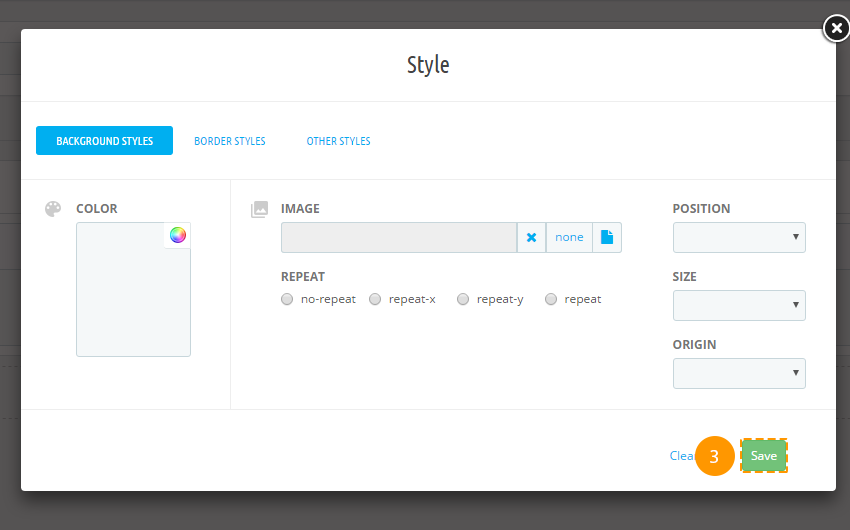
-
If all of the fields are filled in correctly, styles will be saved.
Column
It is an item with configurable block width for different dimensions, based on Bootstrap grid.
Adding the column
-
In order to insert a column into a needed 'row', open the menu (the 'ellipsis' icon) (1)

-
Choose the '+ Add Col' (2) among the list.

-
Fill in the fields (col-xs*, col-sm*, col-md*, col-lg - bootstrap classes) in the pop-up window and press 'Confirm' (3) button.
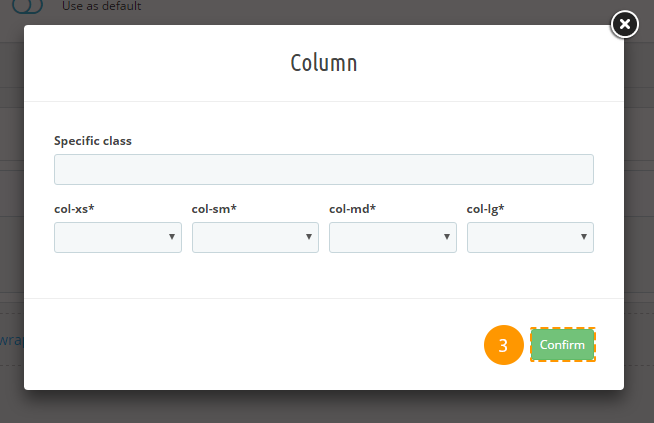
-
The column was added successfully.
Removing the column
Preset item removing will also cause its child items and their styles deleting.
-
In order to remove the column, open the menu (the 'ellipsis' icon) in a column block (1)

-
Press 'Delete' (2) in the list.

-
The column and all of its child items were removed.
Editing the column
-
In order to edit the column, open the menu (the 'ellipsis' icon) (1) in the column block.

-
Press 'Edit column' (2) in the list.

-
Fill in the fields (col-xs*, col-sm*, col-md*, col-lg - bootstrap classes) in the pop-up window and press 'Confirm'.

-
The column was successfully edited.
Adding styles to the column
-
In order to add column styles, open the menu (the 'ellipsis' icon) (1) in a column block.

-
Press 'Stylize' (2) in the list of options.

-
You will see the pop-up window, fill in all the needed fields there (you may refer to the documentation 'Styling' section) and press 'Save' (3) button.
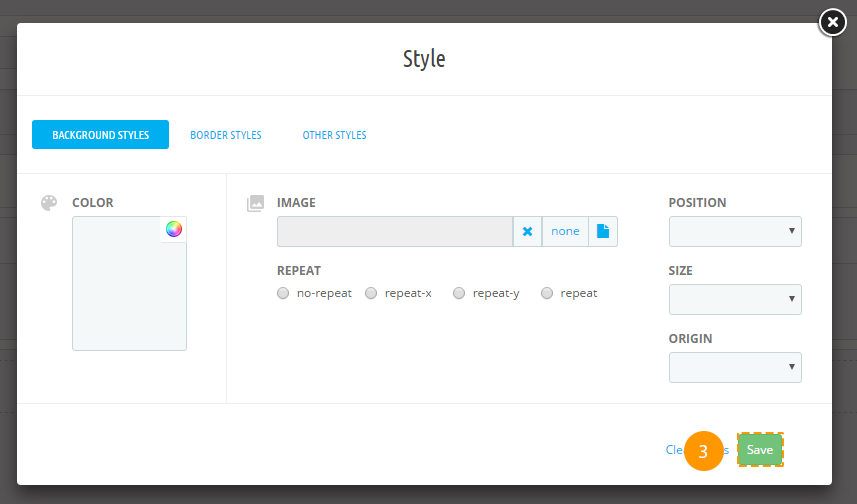
-
If all of the fields are filled in correctly, styles will be saved.
Module
Module assigned to this hook.
Adding the module
Be careful when adding modules to the preset, some of the modules are desirable to use if they do not change the visible layout, e.g., 'Data mining for statistics' module.
-
In order to add the module to the preset in a column block, open the menu (the 'ellipsis' icon) (1).

-
Press the '+ Add Module' (2) in the list of options available.

-
If needed, you can enter the custom class (3) in the pop-up window and select the module (4), next press 'Confirm' (5).
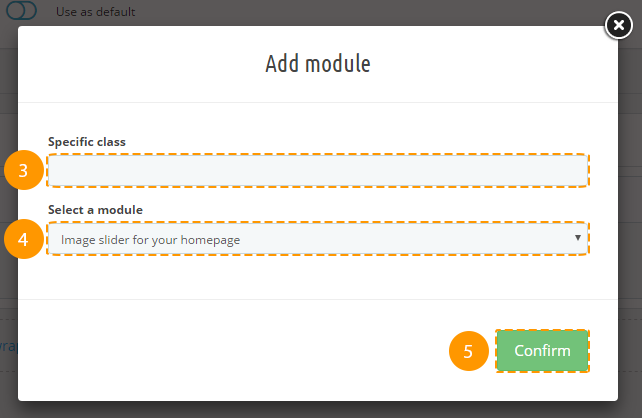
-
The module was successfully added.
-
In this version of TM Mega Layout you can add 'Homepage tabs' module in Home hook.

It can also be customized like all other modules in Mega Layout.
Deleting the module
Removal of preset item will also cause removal of its child items and their styles.
-
In order to remove the module, open the menu (the 'ellipsis' icon) (1) in the module block.

-
Press 'Delete' (2) in the list of options available.

-
The module is removed.
Adding custom class to the module
Custom class adding allows to create module styling using CSS rules.
-
In order to specify custom class for the module, open the menu in the module block (the 'ellipsis' icon) (1).

-
Press 'Edit Settings' (2) then.

-
Specify custom class (3) in the pop-up window and press 'Confirm' (4) button.

-
Custom class was added.
Logo, Copyright
Logo and Copyright blocks are edited the same way as modules, except for the fact that Logo can be placed only in Header or Footer position, and the Copyright block can be placed only in Footer position.
Product Page
Product Info tab
By means of this tab you can switch the layouts of product page. It will appear in the admin panel after making some simple actions described below.
Creating layout
Layouts are created and edited manually.
Create folder 'product_pages' in your theme folder.

- In theme folder find the file 'product.tpl', copy it to the created folder 'product_pages' and rename to 'default.tpl'. To create several layouts - duplicate this file, rename it (e.g. 'layout_1.tpl', 'layout_2.tpl') and change the structure according to your needs.
- Create file 'config.json' in this folder. Copy the following code into it:
{ "default": { "name": "Default", "preview": "default.jpg", "default": 1 } }- "default" - name of .tpl file containing the product page structure.
- "name": "Default" - title of product page layout in module settings.
- "preview": "default.jpg" - preview picture of product page layout in module settings; image should be located in 'product_pages' folder.
"default": 1 - set to '1' if the layout should be set as default
One of the layouts should contain '1' value to be set as default.
This code should be duplicated for each created layout, and contain corresponding values. For example:
{ "default": { "name": "Default", "preview": "default.jpg", "default": 0 }, "layout_1": { "name": "Layout 1", "preview": "layout_1.jpg", "default": 0 }, "layout_2": { "name": "Layout 2", "preview": "layout_2.jpg", "default": 1 } } - Open the 'product.tpl' file in the theme folder. Delete everything and paste the following code:
{include file="$tpl_dir./errors.tpl"} {if $errors|@count == 0} {if isset($megalayoutProductInfoPage) && $megalayoutProductInfoPage} {assign var='path' value="./product_pages/`$megalayoutProductInfoPage`"} {include file=$path} {else} {include file='./product_pages/default.tpl'} {/if} {/if} - To add/edit styles of any product page layout, go to your_theme_folder/css/ and add new folder 'product_pages'. In this folder create file with the layout name and .css extension (e.g. 'default.css', 'layout_1.css', 'layout_2.css'). These files should contain styles of the corresponding product page layout.
- To add scripts to any product page layout, go to your_theme_folder/js/ and add new folder 'product_pages'. In this folder create file with the layout name and .js extension (e.g. 'default.js', 'layout_1.js', 'layout_2.js'). These files should contain scripts of the corresponding product page layout.
Switching layouts
Select 'Product Page' from the dropdown list (1) and click the 'Product Info' tab (2).

In this tab you can switch the layouts of product page. The layout image with the gray border is set as default.

Presets export
Export tool allows you to export presets for the further import into different shops.
-
Navigate to the 'Tools' (1) tab in the main configurations panel.

-
Choose 'Export' (2) in the form.

-
You'll see the list of the existing presets in site hooks.

-
In order to preview the preset, press 'Layout preview' (3) button next to the preset you need, in order to export, please press 'Export layout' (4) button.

-
Then you'll be able to download this preset as a zip archive.
Preset import
Import tool accepts only the presets *.zip files that were previously generated with the same module Export tool.
-
In order to import your preset, you should open the Tools (1) tab and choose 'Import' (2).

-
Next, press the Add file (3) button and select the zip file of your exported preset. In case this archive is the exported preset, you will see this preset preview.

-
If this preset meets your needs, press 'Import' (4). The preset will be imported and added to the list of available presets.

Reset
'Reset' reverts all the presets to initial state (to the way they came with the template), and discards all the created presets.
Attention! After reverting presets to default state, all the custom presets will be discarded!
-
To reset presets, navigate to the 'Tools' (1) tab. In the appeared block open the 'Options' (2) tab.

-
Press the 'Reset' button.

-
That's it! All presets are reset to initial state.
Styles and Scripts Optimization
Styles and scripts optimization adds exclusions for modules in Header section, based on their use in presets. This allows speeding up the page loading speed. Optimization works in test mode.
Enabling optimization:
-
To enable optimization, open the 'Tools' (1) tab and select the 'Options' (2) tab.

-
In the appeared window, you can enable optimization (3).

If optimization is enabled when editing and enabling presets, optimization gets discarded, but you'll see a window offering to run optimization. There is no need to optimize scripts and styles every time you change presets. It's better to optimize them when you're done editing.

Styling
-
Background styles. Fields description:
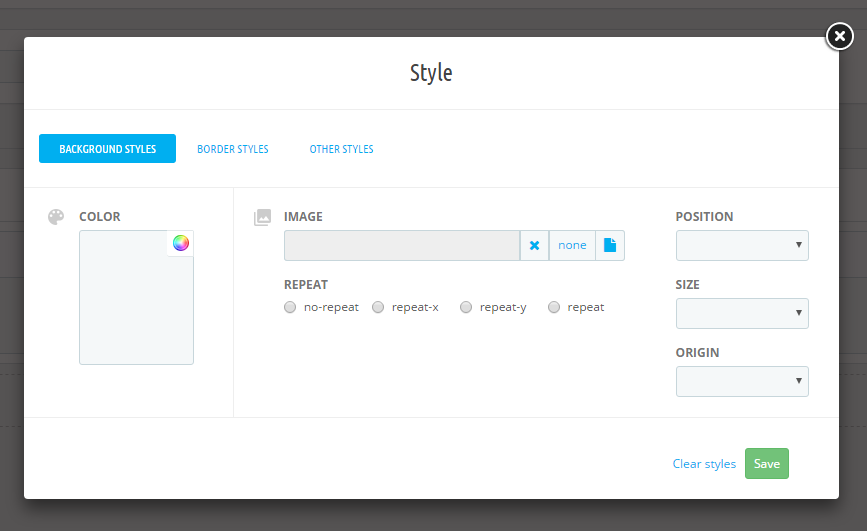
- background-image (background image) - the image URL or 'none' value. The image is picked from the ~/images/cms/ folder.
- background-color (background color) - the value can be set in any color format (rgb, hex, etc.). You can choose the color using the colorpicker tool.
- background-repeat (background repeat) - all of the available options are listed in the radio buttons.
- background-position (background position) - all of the available options are listed in the dropdown.
- background-size (background size) - all of the available options are listed in the dropdown.
- background-origin (background image positioning region) - all of the available options are listed in the dropdown.
Border styles.
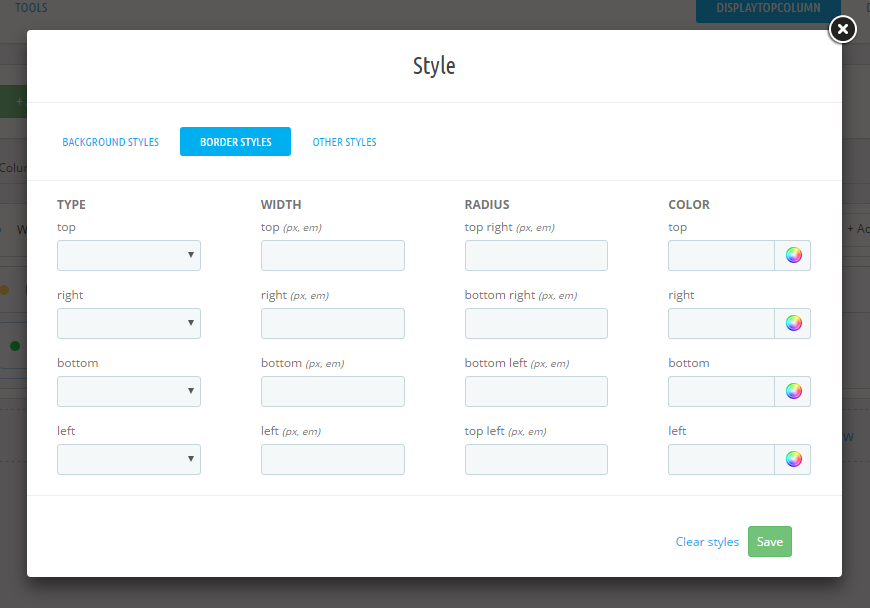
- border-top-style, border-right-style, border-left-style, border-bottom-style (border styles) - all of the available options are listed in the dropdown.
- border-top-width, border-right-width, border-left-width, border-bottom-width (borders width) - should be set in pixels.
- border-top-сolor, border-right-color, border-left-color, border-bottom-color (borders color) - the value can be set in any color format (rgb, hex, etc.). You can choose the color using the colorpicker tool.
- border-top-right-radius, border-top-left-radius, border-bottom-right-radius, border-bottom-left-radius (border radius) - should be set in pixels.
Other styles.
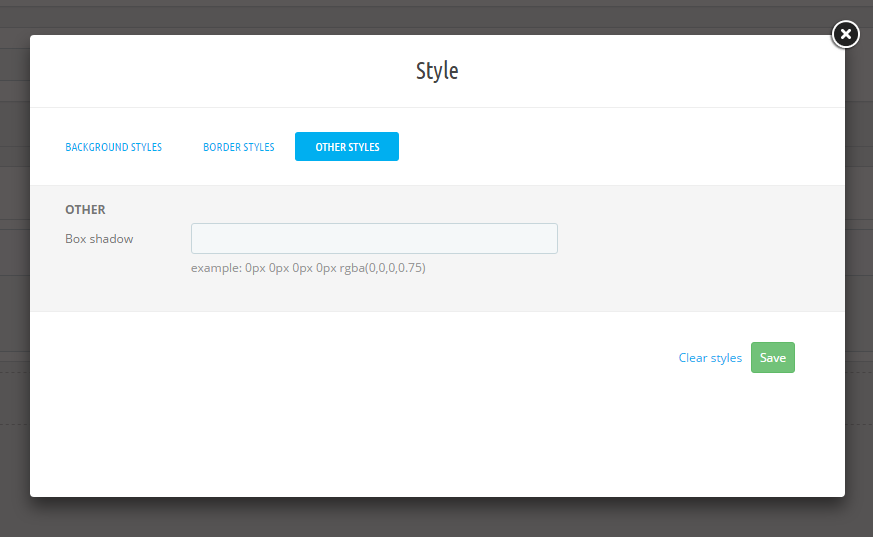
- box-shadow (box shadow) - example:0px 0px 0px 0px rgba(0,0,0,0.75).
Items styles removing
-
In order to remove items styles, open the items styling section and press 'Clear styles' (1)
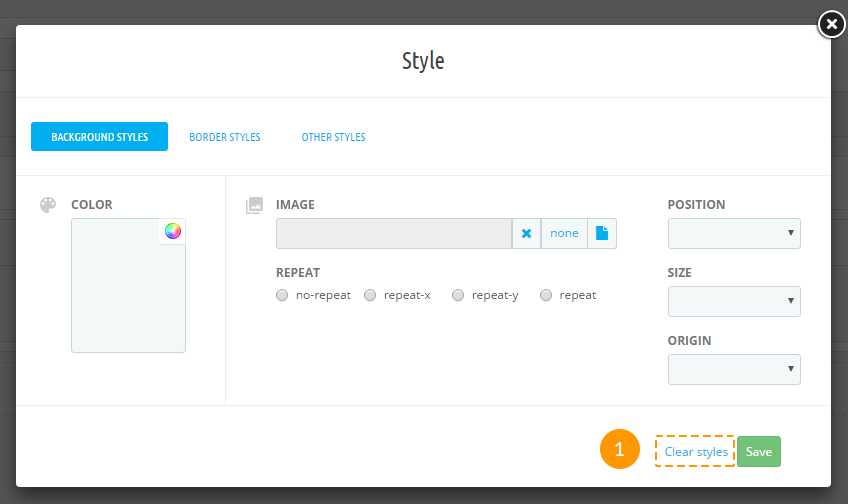
Warnings
If the following message appears in the module item block, you should enable the mentioned module.

If the following message appears in the module item block, you should install the mentioned module.

In case you remove or deactivate the 'TM Mega Layout' module, all of the active presets will be disabled and you will see the positions (hooks) in their original appearance.
TM Mega Menu
The module is designed to create complex menus. The module provides the ability to display one item (without sub-menu), a menu item with a sub-menu and a menu item with sub-menu by means of a multi-row and multi-column block. The module can be used in different positions, but it will display the same content. Available positions: top (displayTop), left (displayLeftColumn), right (displayRightColumn), footer (displayFooter). You can add categories (with subcategories), CMS categories (with subcategories), manufacturers (one or a list), suppliers (one or a list), stores (if multistore is used), links to any product, information block about the product, custom links (not limited in quantity), custom HTML blocks (not limited in number) and banners. See below for more details.
The module includes 6 main tabs that allow to customize the menu.

TM Mega Menu Items
TM Mega Menu items are the basic items which appears in the menu.
In order to create a new item, open the TM Mega Menu module and click Add item button from the top menu or click "+" button in the top right of the table.

In the form that appears, fill in the required fields.
-
- Enter item name
- the tab title which is mandatory to be filled in for the default language, if the additional languages fields are not filled in, the tab takes its name from the default language.
-
- Active
- active/inactive tab.
-
- Link
- a link that is assigned to this tab. You can enter a custom link, or choose from existing options (categories, CMS categories). If you leave the field blank, the link of this tab is inactive.
-
- Sort order
- the order of tabs to be displayed.
-
- Specific Class
- the class which is added to emphasize the item (CSS class).
-
- Enter item badge
- is filled in depending on multi-languages.
-
- It is Mega Menu
- given tab sub-menu is a Mega Menu. *
-
- Use simple menu
- given tab sub-menu is a simple menu. **
* It is Mega Menu. If this option is selected, there will be a form to create a complex menu (Mega Menu).
** Use simple menu. If this option is selected, there will be a form to create a simple menu. This is a menu that displays the selected content in a single column. If the menu has embedded content, the new column is added.
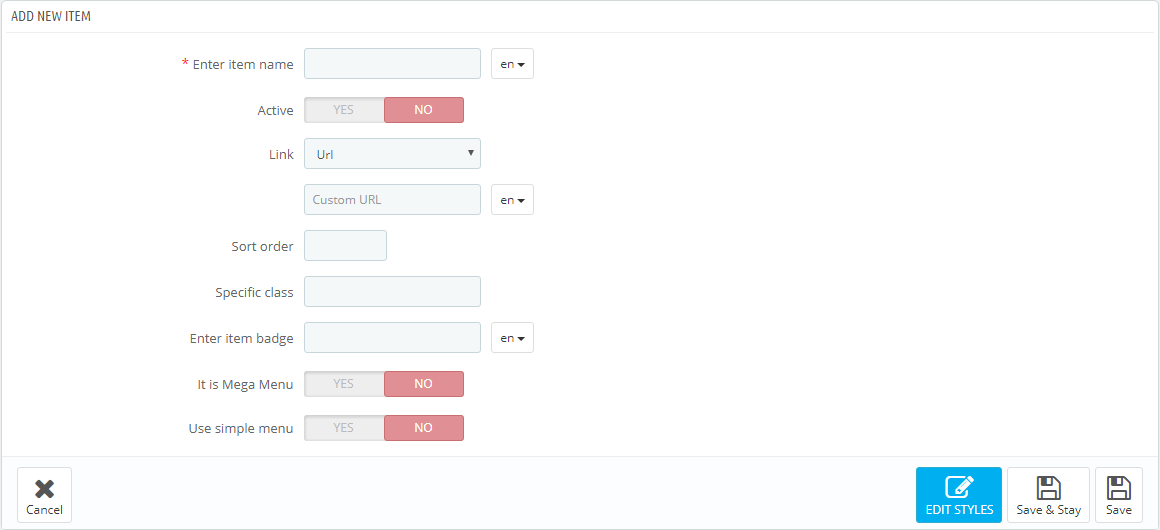
Complex menu consists of rows and columns in rows.
The Row is a part of the Mega Menu structure. It includes the menu columns. The existing row can be removed by clicking the appropriate button. The row will be removed with the content it includes. The rows quantity is not limited.
The Column is a part of the Mega Menu structure, which is placed inside the rows. (The Class) The width of the column cannot be less than 2 and more than 12. In order to make the menu display properly, the total column width cannot exceed 12. The width (class) is a Bootstrap column type, corresponds to the same values.
In order to create the menu, click the 'Add row' button.
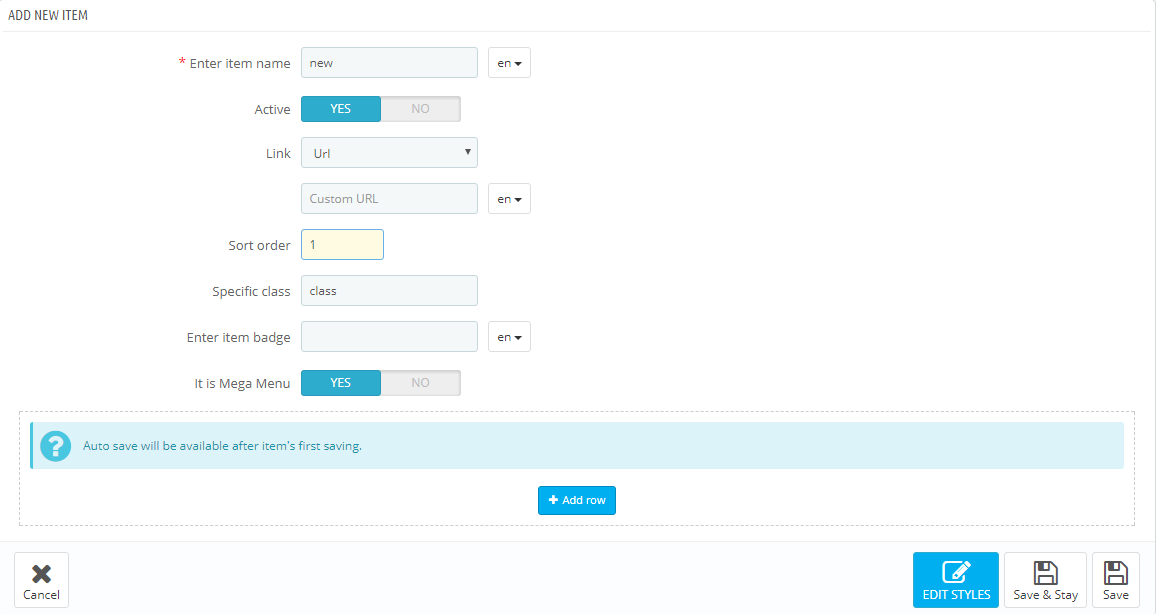
In the form appeared, click 'Add column' button.

In the pop up window you need to specify the column class (from 2 to 12). The column itself appears next where you need to set the required settings.
Here you can change the column class, CSS class and the content from the list provided. You can add/remove content by double clicking the item, or by highlighting the items and clicking the corresponding button.
Block can be removed by clicking 'Remove block' button in the footer of the block.
By removing the row, the included columns are also removed.

In order to move the content available in the selected menu, double-click or highlight the desired content and press the corresponding button.
Inactive menu information is saved while switching between menu types and you can always change the type of menu.
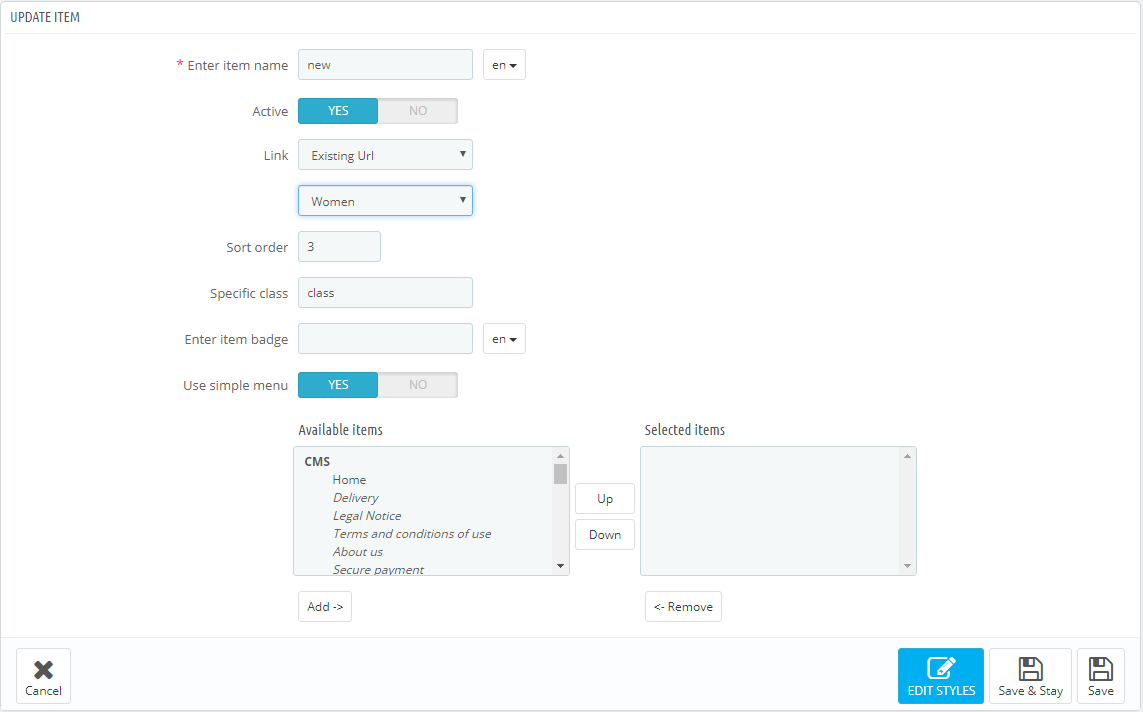
TM Mega Menu HTML
In this section we will explain how to create a custom HTML block in the Mega Menu.
The module has a table listing all the available blocks. You can also add a new block by clicking the '+' button in the top right of the table.
In the form that appears, fill in the required fields.
-
- Enter HTML item name
- HTML block name, is mandatory to be filled in for the default language.
-
- Specific class
- block's CSS class.
-
- HTML content
- HTML content.
Added block will appear in the list of blocks, as well as in the list of available content while creating menu blocks.

TM Mega Menu Links
In this section we will show how to create custom links in the Mega Menu.
The module has a table listing all the available links. You can also add a new link by clicking the '+' button in the top right of the table.
In the form that appears, fill in the required fields.
-
- Enter Link name
- link name, is mandatory to be filled in for the default language.
-
- Enter Link URL
- link URL, is mandatory to be filled in for the default language.
-
- Specific class
- block's CSS class.
-
- Open in new window
- open link in a new window.
Added link will appear in the list of links, as well as in the list of available content while creating menu blocks.

TM Mega Menu Banners
In this section we will explain how to create banners in the Mega Menu.
The module has a table listing all the available banners. You can also add a new banner by clicking the '+' button in the top right of the table.
In the form that appears, fill in the required fields.
-
- Select a file
- select a file, is mandatory to be filled in for the default language.
-
- Enter Banner name
- banner title, is mandatory to be filled in for the default language.
-
- Enter Banner URL
- link URL, is mandatory to be filled in for the default language.
-
- Specific class
- block's CSS class.
-
- Public Title
- public banner title.
-
- Description
- set the description of the banner.
-
- Open in new window
- open link in a new window.
Added banner will appear in the list of banners, as well as in the list of available content while creating menu blocks.

TM Mega Menu Video
In this section we will explain how to add a video in the Mega Menu.
The module has a table listing all the available videos. You can also add a new video by clicking the '+' button in the top right of the table.
In the form that appears, fill in the required fields.
-
- Enter Video Name
- video title (the field is required).
- Enter Video URL - add video link in the formats described below:
- If this is a YouTube video, click on Embed and copy the code between the quotes for https://www.youtube.com/embed/video_id
- If this is a Vimeo video, click on Share icon and in the Embed section copy the source code between the quotes for http://player.vimeo.com/video/video_id
Added video will appear in the list of videos, as well as in the list of available content while creating menu blocks.

TM Mega Menu Map
In this section we will explain how to add a map in the Mega Menu.
The module has a table listing all the available maps. You can also add a new map by clicking the '+' button in the top right of the table.
In the form that appears, fill in the required fields.
-
- Enter Map item name
- the title of the map.
-
- Enter Map latitude
- set a latitude value.
-
- Enter Map longitude
- set a longitude value.
-
- Marker
- adding a custom marker.
-
- Enter Map scale
- the scale of the map (used 8 by default).
-
- Map description
- set the description of the map.
Added map will appear in the list of maps, as well as in the list of available content while creating menu blocks.
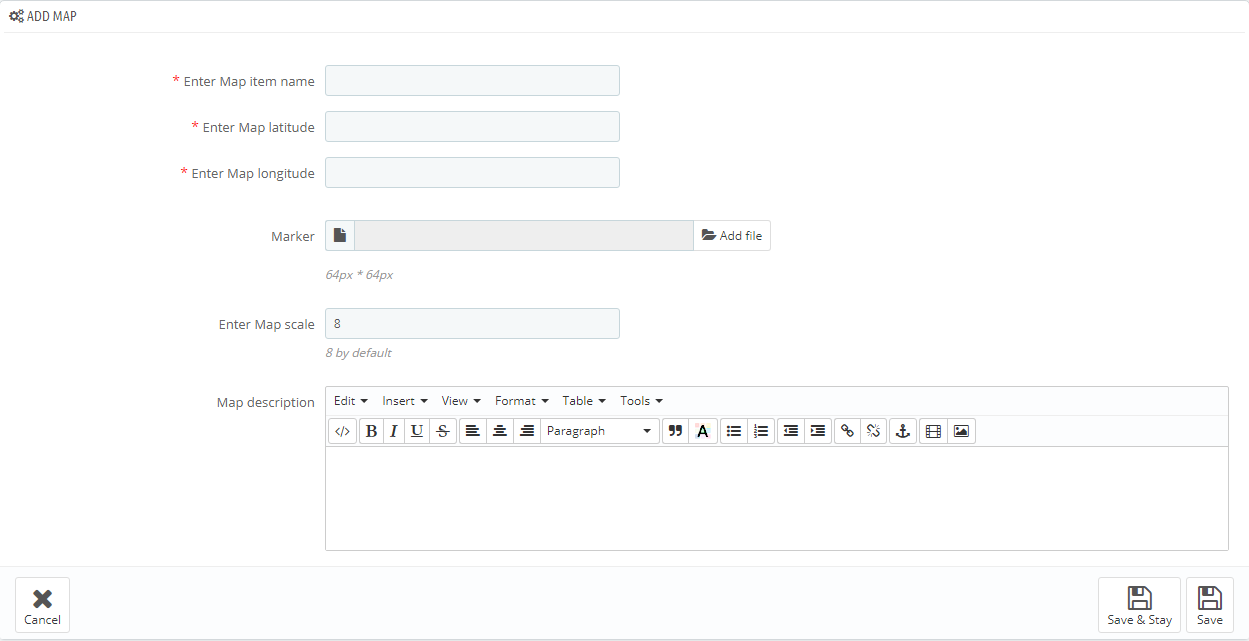
TM Olark Chat
Module to display Olark Chat on your store front-end.
Module install/uninstall
This module can be installed/uninstalled as any other PrestaShop module.
Module settings
After module has been installed you can configure it on the module configuration page.
In order to configure Olark Chat, which you can see on the live demo of the template, you need to register on the official website and to get the ID for your website. Input your ID to the field "Olark site ID" and set module under "Live mode". Now save settings by clicking 'Save' button.

TM Product List Gallery 2.0.0
This module displays all the available product images in form of a gallery on product listing pages. Depending on what settings you choose, the module can display images in form of a rollover or slideshow.
Module Installation and Deleting
This module can be installed and deleted like any other PrestaShop module.
Module settings
After the module is installed, navigate to \themes\classic\templates\catalog\_partials\miniatures\product.tpl. Open this
file and find the following code:

and replace it with:

After installing and connecting the module, you can set it up on the module configuration page.
The module has the following main settings:
- Live mode - ability to use the module in live mode.
- Type - select display type: rollover, gallery or slideshow.
If you choose rollover, you can choose the animation effect:
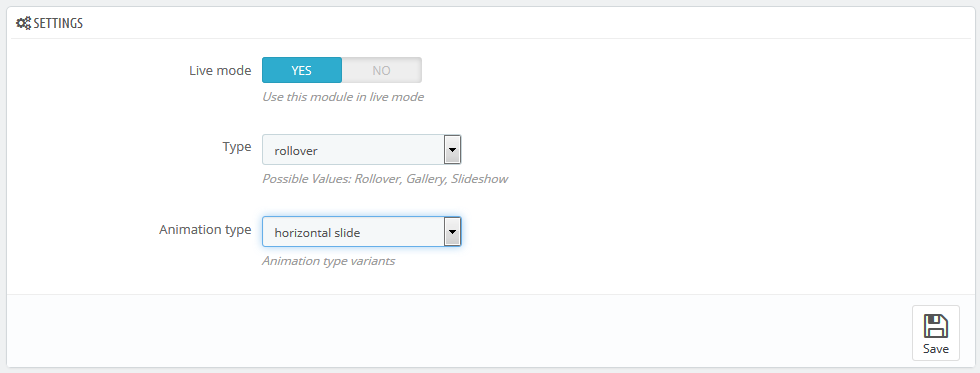
- Opacity slide - opacity changes;
- Horizontal slide - horizontal;
- Vertical slide - vertical.
If you choose gallery, you will find the following settings available:

- Display items - the number of items displayed;
- Visible items in row - the number of items in a row;
- Use carousel - enable/disable the carousel for this block.
If you choose slideshow, you will find the following settings available:
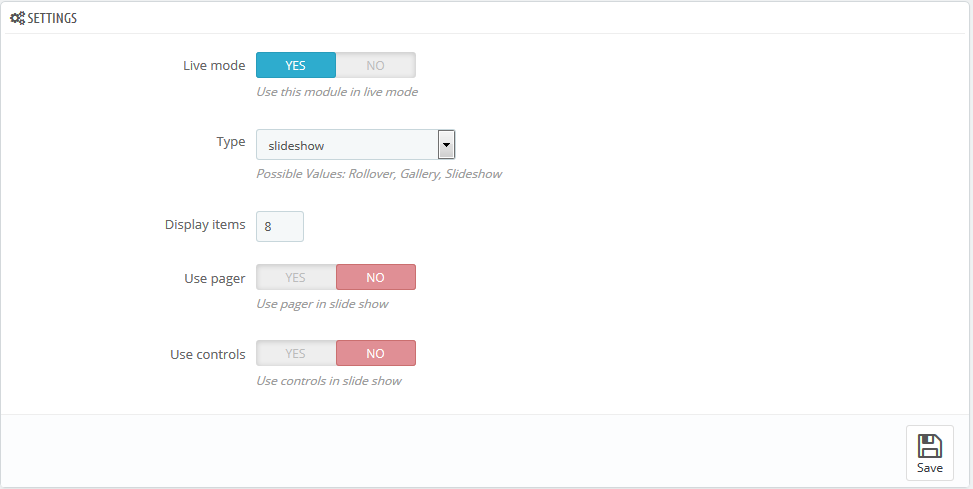
- Display items - the number of items displayed;
- Use pager - pager display in slide show;
- Use controls - controls display in slide show.
TM Search 1.1.0
This module is an extended search version that allows you to select a specific category for searching within its content. You can also change the category after defining the query. It also provides a possibility to set the additional product information display (description/price/manufacturer, etc.), and define the search results container layout, e.g., you can divide the results into a few sections with the controls (pagination, next/previous/show all). All the module settings are available in main admin panel.
Installation and Deleting
The module is installed and deleted like any other Prestashop module.
Module configuration
After module has been installed you can set it up on the module configuration page.
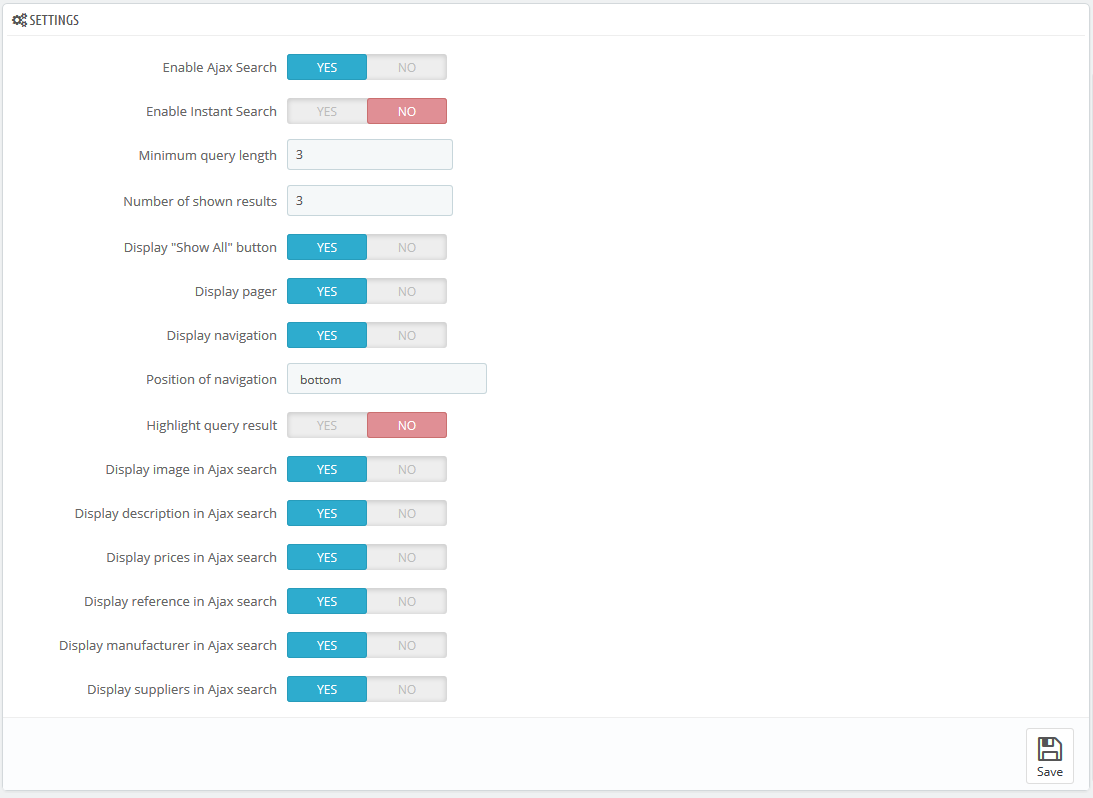
- Enable Ajax Search - enables live search in a dropdown.
- Enable Instant Search - enables instant search.
- Minimum query length - number of symbols to start the result display.
- Number of shown results - number of products that shows up in the results section (number of products per page for the "pager" or "navigation" mode).
- Display "Show All" button - displays the 'Show all' button below the results section, the click on it displays all found results.
- Display pager - divides results into pages (depends on the 'Number of shown results' field value) and displays links to them.
- Display navigation - shows the Previous/Next buttons.
- Position of navigation - hook(s), to show the navigation (top/both/bottom options are available).
- Highlight query result - highlights the text that matches search query.
- Display image in Ajax search - shows product images in the results section.
- Display description in Ajax search - shows product description in the results section.
- Display prices in Ajax search - shows product price in the results section.
- Display reference in Ajax search - shows product reference in the results section.
- Display manufacturer in Ajax search - shows product manufacturer in the results section.
- Display suppliers in Ajax search - shows product suppliers in the results section.
Some parameters might differ depending on the combination used.
